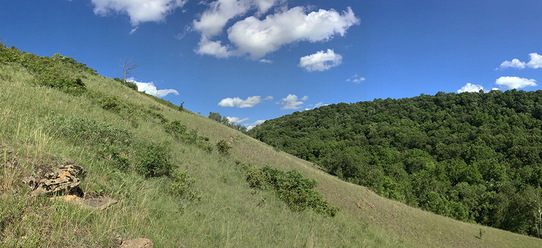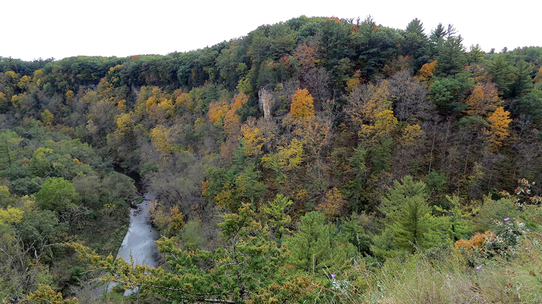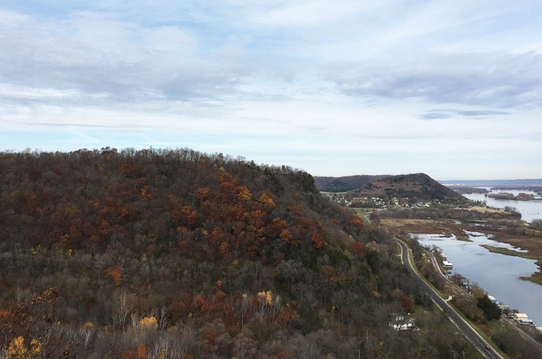|
Summer 2018
Minnesota’s Blufflands Landscape
Ancient and Remarkably Diverse
By Hannah Texler, Plant Survey Supervisor, Minnesota Biological Survey
I am lucky enough to have spent a lot of my time while working for the Minnesota DNR in the Blufflands in the southeast part of the state. It’s become one of my favorite parts of Minnesota.
Also referred to as the driftless area or coulee country, this is a landscape at once majestic and intimate, ranging from vertical cliffs and wide vistas to narrow valleys, winding creeks, and a myriad of different habitat niches. Despite the relatively small size of this landscape compared to others in Minnesota, the biological diversity here is higher than in any other part of the state! Minnesota’s endangered, threatened, and special concern species list includes 189 plants and animals that reside here. The region also has the highest number of animal species of greatest conservation need in the state.
 Bedrock bluff prairie and mesic hardwood forest at Mound Prairie Scientific and Natural Area. Photo by Kelly Randall
If geography and ancient history ruled, southeast Minnesota would probably be a separate state combined with parts of neighboring Wisconsin, Iowa, and Illinois. Together, these 18 million acres are called the Paleozoic Plateau. It sits on top of layers of bedrock formed over 250 million years ago under a vast sea. After the sea receded, glacial streams—which eventually became the Mississippi River and its tributaries—carved into the bedrock and created a hilly, dissected landscape. Much of the bedrock was composed of limestone and dolomite. Water and other natural forces shaped these soluble rocks into caves, sinkholes, and underground drainage, creating a type of topography known as karst.
The Paleozoic Plateau was largely missed by the last glaciers to move across the state. So instead of being covered by glacial sediments like most of the rest of Minnesota, this rugged ancient landscape is still visible today.
Why is this region of the state so packed with diversity? Part of the answer lies in its varied topography—steep slopes, floodplains, groundwater seepage areas, high ridge tops, and cliffs. These landscape features support native plant communities specially adapted to thrive under those conditions.
And why so many rare species? One factor is Minnesota’s position at the northwestern edge of North America’s Eastern Broadleaf Forest Province. Many of the species found here are rare in the state because they are at the western or northern edge of their range. For example, in Minnesota the timber rattlesnake (Crotalus horridus) is found only in the Paleozoic Plateau, but this species ranges more widely throughout eastern North America in appropriate habitats. The blufflands provide an ideal mix of habitats for these snakes—forests and prairies for summer habitat, and rock outcrops for winter dens.
Some rare aquatic species are at the northern edge of their range in southeastern Minnesota. One is the crystal darter (Crystallaria asprella), a small, pale-yellow fish of large clear-water streams with moderate to swift currents. For a handful of rare species, the blufflands are key to their survival: Seven rare species have their primary range here in special habitat conditions. Glade mallow (Napaea dioica) is a tall, summer-blooming floodplain plant that is endemic to the region, meaning it is found nowhere else in the world.
 The blufflands at Whitewater WMA in southeastern Minnesota. Photo by Hannah Texler
Native Habitats
Bedrock bluff prairies are also known as goat prairies because their extreme steepness seem best suited for goats to climb. This unique blufflands habitat occurs on south- to west-facing slopes, where dry conditions slow the growth of trees and shrubs. Fires historically helped to keep these areas open and dominated by over 200 species of native grasses and wildflowers.
Wooded slopes and ridge tops surround the goat prairies. Red oak, white oak, bur oak, and shagbark hickory are some of the characteristic trees of these fire-dependent forest communities.
On cool north- to east-facing slopes and on narrow valley floors along streams and seeps, a variety of forested plant communities are found. Mesic hardwood forests are dominant, with canopies of sugar maple, basswood, red oak, and often white pine, especially on rocky upper slopes. Here, cool, shady conditions make fires much less frequent. Thick layers of leaf litter break down to build up deep, loamy soils rich in nutrients. Before tree buds unfurl in spring, carpets of spring-ephemeral wildflowers cover the forest floor. One of these, the diminutive white-flowered squirrel corn (Dicentra canadensis), is found nowhere else in the state. By summer, the ground is covered by many of the 40 species of ferns that occur in the blufflands together with later-blooming wildflowers.
Higher up the slopes in the coolest, rockiest valleys, habitat remnants from the last ice age persist. Here, winter ice stays in the limestone bedrock crevices well into summer. Air moving through these rock fissures is cooled and slowly melts the ice. Where cool air and icy water emerge, thick moss carpets and northern plants grow. Balsam fir, Canada yew, and the endangered Iowa golden saxifrage (Chrysosplenium iowense) occur in these places. These northern plants are remnants from 10,000 years ago when the climate was colder and these species more common.
Tiny snails discovered here, know only previously from the Pleistocene era, depend on the continuous presence of cold air, reside on many of these slopes. One federally threatened plant, Leedy’s roseroot (Rhodiola integrifolia ssp. Leedyi), is known from only seven places in the world—four of them on these persistently cold cliffs in Olmsted and Fillmore counties.
These cliffs and slopes are extremely fragile places—one misstep could send rocks, snails and plants (or a person) tumbling downhill.
Another mosaic of native plant community types resides along the region’s big rivers, including the Mississippi and its major tributaries the Root, Zumbro, Cannon, and Vermillion rivers. Their floodplains hold marshes and sedge meadows, as well as floodplain forests dominated by silver maple, green ash, cottonwood, river birch, and swamp white oak.
More than 150 bird species breed in or migrate through the floodplain habitats. Nearly half of North America’s songbirds and 40 percent of its waterfowl spend at least part of their lives in the Mississippi flyway. Bright-blue cerulean warblers (Setophaga cerulea), brilliant yellow-orange prothonotary warblers (Protonotaria citrea), and soaring red-shouldered hawks (Buteo lineatus) are some of the birds at the western edge of their range here.
This article is an excerpt from a story first published in the Minnesota Conservation Volunteer.
 Mesic hardwood forest and the City of Brownsville from Brownsville Bluff Scientific and Natural Area. Photo by Kelly Randall
These Scientific and Natural Areas in the blufflands allow you to see these native habitats for yourself:
|